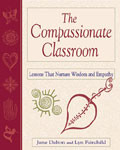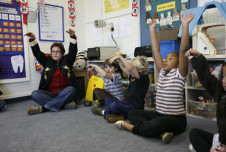Veteran teachers Jane Dalton and Lyn Fairchild’s greatest concern in the classroom is not with raising their students’ test scores. It is with raising consciousness. Specifically, Dalton and Fairchild are interested in encouraging students to get to know and appreciate themselves, their community, and the world around them. Dalton and Fairchild have named this type of consciousness “spiritual literacy,” and though it is lacking in modern society, they argue, it can be cultivated in the classroom. With The Compassionate Classroom: Lessons That Nurture Wisdom and Empathy, they want to help teachers do just that. To that end, they’ve produced a well-organized book rich with wisdom, creativity, and concrete lesson plans.
The 40 lesson plans in the book each center on a different theme, such as wonderment, mindfulness, or grace. In relating the importance of each theme to classroom life, the authors provide detailed descriptions of how that theme has been considered by religious and secular philosophies, and outline in-class projects for making these philoso¬phies come alive in the classroom.

For example, to foster mindfulness, Dalton and Fairchild offer a simulation where students are given prisoner rations of bread and read a passage from a novel describing prisoner life, thereby encouraging them to appreciate the food and freedoms they have in their own lives. In the chapter on creativity, the authors suggest asking students to draw with their non-dominant hand, thus dissolving self-consciousness and promoting enjoyment of the artistic process.
It is obvious that the authors have drawn largely upon their own experiences. This is most evident in the anecdotes that appear in every chapter, illustrating powerful moments of student inspiration, tough decision-making, and revelations by teachers and students alike. In the chapter on grace, Fairchild describes an encounter with one of her students, whom she catches stealing cookies from the cafeteria. Although she is shocked, she decides to let the child go free when she realizes that he has learned his lesson by simply being caught in the act. In this way, Fairchild stresses her belief that it is most important to help children grow from their mistakes by granting second chances.
The authors close each chapter with a question designed to encourage readers to think about ways they could add a personal touch to the lessons. More than anything else, the authors want to make the classroom a more human, caring place. If teachers are to awaken compassion and creativity in their students, it helps to have veterans like Dalton and Fairchild nurturing the compassion and creativity of teachers.





Comments
Thank you for a beautiful review. Jane Dalton, Director and Assistant Professor of Art Education, Maine College of Art
Jane Dalton | 11:19 am, November 24, 2010 | Link